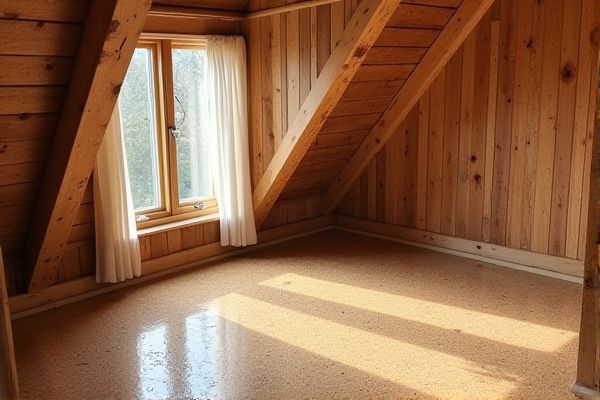
Attic cork flooring offers excellent insulation and soundproofing benefits with a soft, resilient surface, while bamboo flooring is renowned for its durability, eco-friendliness, and water resistance. Discover which flooring option best suits your space and lifestyle to make an informed decision by reading the rest of the article.
Table of Comparison
| Feature | Attic Cork Flooring | Bamboo Flooring |
|---|---|---|
| Material | Harvested from cork oak bark | Made from fast-growing bamboo grass |
| Durability | Moderate; resilient but can dent under heavy impact | High; extremely hard and resistant to wear |
| Eco-Friendliness | Renewable, biodegradable, and recyclable | Highly sustainable due to rapid growth and renewability |
| Comfort | Soft, warm, and comfortable underfoot | Harder surface; less cushion than cork |
| Moisture Resistance | Good resistance but can degrade with prolonged water exposure | Better moisture resistance; suitable for humid environments |
| Maintenance | Easy; requires regular sweeping and occasional waxing | Low maintenance; simple cleaning with damp mop |
| Installation | Floating or glue-down method | Click-lock or glue-down installation |
| Cost | Mid-range pricing | Varies; generally affordable to mid-range |
| Appearance | Natural, soft texture with matte finish | Smooth, glossy finish with visible grain |
Introduction: Attic Cork Flooring vs Bamboo Flooring
Attic cork flooring offers natural insulation, soundproofing, and a soft underfoot feel, making it ideal for energy-efficient attic spaces. Bamboo flooring provides exceptional durability, moisture resistance, and a sleek, modern aesthetic suited for high-traffic areas. Both materials are eco-friendly, but cork excels in thermal and acoustic properties, while bamboo leads in hardness and maintenance ease.
Material Composition and Sustainability
Attic cork flooring is made from the bark of cork oak trees, harvested sustainably without harming the tree, making it an eco-friendly and renewable choice with natural insulation properties. Bamboo flooring, derived from fast-growing grass rather than wood, offers a highly renewable material that absorbs carbon dioxide quickly during growth, contributing to environmental sustainability. Your decision between these options should consider cork's softer, more cushioned feel and bamboo's strength and hardness, both providing environmentally conscious flooring solutions.
Installation Process Comparison
Attic cork flooring offers a straightforward installation process with floating planks that easily click together, making it suitable for DIY projects and uneven surfaces often found in attics. Bamboo flooring typically requires more skill during installation due to its need for precise nailing or gluing, especially on subfloors that must be smooth and dry. Cork's natural flexibility allows for easier accommodation of attic temperature fluctuations, while bamboo demands more careful acclimatization before installation to prevent warping.
Durability and Longevity
Attic cork flooring offers excellent durability due to its natural resilience and ability to compress and recover, making it resistant to cracks and dents over time. Bamboo flooring is known for its impressive hardness and longevity, often outperforming traditional hardwoods in wear resistance, especially strand-woven varieties. Your choice between attic cork and bamboo flooring should consider the expected foot traffic and climate conditions to ensure long-lasting performance.
Comfort and Insulation
Attic cork flooring offers superior comfort and insulation due to its natural cellular structure that provides excellent thermal resistance and sound absorption, making it ideal for maintaining warmth in attic spaces. Bamboo flooring, while durable and eco-friendly, tends to be harder and less insulating, often requiring additional underlayment to improve comfort and thermal efficiency. Cork's inherent softness underfoot and low thermal conductivity enhance energy efficiency and reduce noise, outperforming bamboo in attic-specific comfort and insulation needs.
Aesthetic Appeal and Style Options
Attic cork flooring offers a warm, natural look with unique textures and earthy tones, enhancing cozy and rustic interior styles. Bamboo flooring provides a sleek, modern aesthetic with a wide range of colors and grain patterns, fitting both contemporary and traditional designs. Your choice depends on whether you prefer the soft, cushioned feel and distinctive appearance of cork or the durable, elegant finish of bamboo.
Maintenance and Cleaning Requirements
Attic cork flooring requires regular sweeping and occasional damp mopping with a pH-neutral cleaner to maintain its moisture-resistant and durable surface, while avoiding excessive water to prevent damage. Bamboo flooring demands routine cleaning with a soft broom or vacuum, plus a slightly damp mop using a manufacturer-recommended cleaner to preserve its natural hardness and resist scratches. Both flooring types benefit from prompt spill wipe-ups and protective pads under furniture to extend their lifespan and appearance.
Cost and Budget Considerations
Attic cork flooring typically ranges from $3 to $8 per square foot, offering an affordable option with natural insulation benefits, while bamboo flooring costs between $5 and $10 per square foot, reflecting its durability and eco-friendliness. Cork requires less subfloor preparation, potentially lowering installation expenses compared to bamboo, which may need a more even surface and professional fitting to prevent moisture damage. Budget planning should factor in long-term maintenance costs, as cork flooring may need periodic sealing, whereas bamboo's hardness can reduce replacement frequency, influencing overall investment durability.
Environmental Impact and Eco-Friendliness
Attic cork flooring is highly sustainable, harvested from the bark of cork oak trees without harming the tree, which regenerates over time, making it an eco-friendly choice. Bamboo flooring grows rapidly and requires less water and pesticides compared to traditional hardwoods, but its environmental impact varies depending on harvesting and manufacturing practices. Your decision between cork and bamboo flooring can significantly influence your home's ecological footprint, with cork offering better renewability and bamboo providing fast-growing resource benefits.
Pros and Cons: Which Is Best for Your Attic?
Attic cork flooring offers excellent insulation and sound absorption, making it ideal for temperature regulation and noise reduction, but it is softer and less durable than bamboo. Bamboo flooring excels in strength, sustainability, and moisture resistance but may require additional insulation for attic comfort. Your choice depends on priorities: choose cork for cozy, quiet spaces or bamboo for durable, eco-friendly flooring with added insulation needs.
 homyna.com
homyna.com